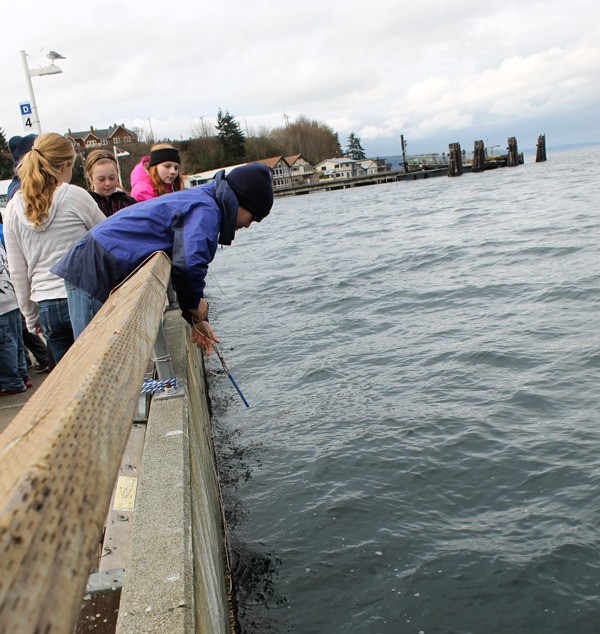South Whidbey sixth and seventh-grade students are learning firsthand about Puget Sound’s aquatic ecosystem through the Langley Middle School Oceanography Program.
The program provides students with the opportunity to learn through field-based studies at South Whidbey Harbor marina in Langley and lab studies in the classroom.
Whidbey Watershed Stewards partnered with South Whidbey School District for the course, which is now in its second year. Last year, the program was only open to sixth graders. But thanks in part to a grant of $1,280 from the South Whidbey Schools Foundation, as well as funding from the Rose Foundation and Langley Community Club, seventh graders are now participating. The seventh graders are building upon the knowledge gleaned from sixth-grade studies to examine marine conditions related to plankton population and health through collection, reporting and analysis; seventh-grade curriculum is primarily focused upon the technological aspect of collection and evaluation. Eventually, organizers hope to extend the program with eighth graders.
The program is ongoing throughout the school year allowing students to make predictions and examine seasonal fluctuations.
“They are not just studying science, they’re being scientists,” said Susan Milan, a seventh-grade Langley Middle School teacher.
Milan explained that the kids are learning about pH, dissolved oxygen, temperature and salinity and the ways in which these factors relate to plankton species, credited as being the base of the Salish Sea food web. Milan said they are also examining the resident orca population and chinook salmon populations.
A significant question Milan said the students will ponder is, “How do our everyday actions connect to environmental and human health?”
“We are the generation that is going to have to deal with what is happening to the ocean,” said seventh-grade student Megan Reeves.
“It teaches what goes on around us, how it relates to us, because it’s right there,” said Ahnika Burt, another seventh-grade student, referring to the ocean and its effects on human life.
Lori O’Brien, Whidbey Watershed Stewards education director, instructed a group of seventh-grade students at the marina dock last week. The students, she explained, were gathering samples, making scientific predictions and checking their predictions.
The students were divided into three groups, one of which was performing water quality tests with a Van Dorn bottle.
A second group, at the far end of the dock, collected plankton and studied the effects of ocean acidification.
In addition to the firsthand collection and examinations, said O’Brien, the students compare their data with that collected by the Northwest Association of Networked Ocean Observing Systems from buoys near Sandy Point and Mukilteo.
The students are getting a lesson in engineering as well, she said. Sixth graders are designing plankton nets in order to develop their own testing method to try out. Each month, the students make design adjustments in order to increase effectiveness. Similarly, seventh graders have been tasked with devising a way to place a thermometer inside the Van Dorn bottles for a more accurate temperature reading.
Rick Baker, executive director for Watershed Stewards, has experience working in oceanography education, having previously run the education program for the Ocean Institute in Southern California for 22 years plus 12 years teaching oceanography at a community college.
Baker said the kids are “thrilled” about the program and are “really psyched” about the opportunity to examine plankton up-close and run tests.
The organized stations and activities, said Baker, are often supplemented by aquatic visitors such as jellyfish and harbor seals. Recently, he added, the students were also able to speak with a scuba diver who was examining the sea star wasting syndrome.
At the end of the school year, seventh graders will do offshore studies from aboard a boat.
“It teaches them the scientific process, which I think is really important. A lot of people don’t know how science works,” said Baker. “If you take kids to a museum or aquarium, it’s one shot. Kids are there for one day and then they go home and forget what they did. This is ongoing.”



